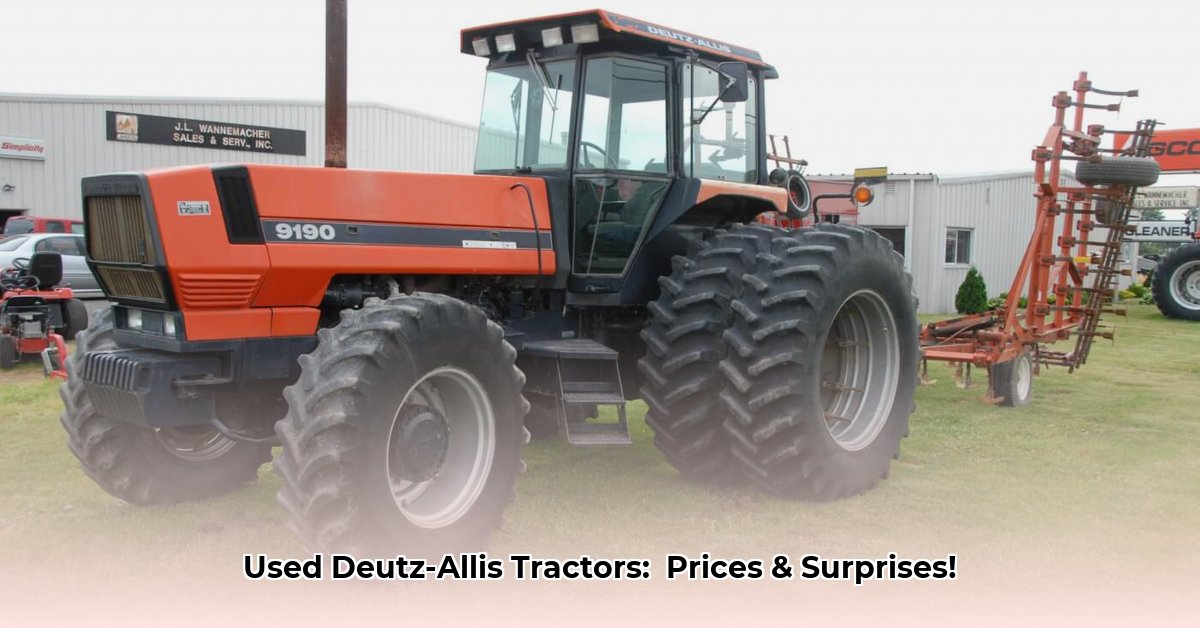
The legacy of Deutz-Allis tractors is interwoven with agricultural history and significant business transitions. Born from the merger of Deutz and Allis-Chalmers, the brand, though short-lived, left an indelible mark on farming. The shift from the iconic Allis-Chalmers orange to the Deutz-Allis green was a pivotal moment, met with mixed reactions from loyal customers. This, coupled with other factors, ultimately led to the brand's discontinuation. However, their sturdy build and reputation for reliability ensure that Deutz-Allis tractors remain highly sought after by collectors and farmers alike. But what drives their continued appeal and how can you navigate the used market? For more Allis Chalmers history, check out this Allis Chalmers history.
What Influences the Price of a Used Deutz-Allis Tractor?
Several crucial factors determine the price of a used Deutz-Allis tractor. Age is a primary driver; older models naturally command lower prices. Horsepower significantly impacts value – higher horsepower tractors fetch higher prices. The condition of the tractor plays a vital role; meticulously maintained machines demand a premium compared to neglected ones. Finally, the presence of additional features and attachments increases the overall value. Think of it like buying a used car; a well-maintained, low-mileage vehicle will always cost more than a neglected, high-mileage counterpart.
Understanding Used Deutz-Allis Tractor Price Ranges
The price of a pre-owned Deutz-Allis tractor can vary considerably. Smaller, older models can be found for under $4,000, while larger, newer models can easily exceed $50,000. This wide range reflects differences in age, size, condition, and specific features. The following table provides estimated price ranges; however, these are approximations and prices may fluctuate based on location and market conditions.
| Model Type | Approximate Price Range (USD) |
|---|---|
| Smaller, Older Models | $4,000 - $15,000 |
| Mid-size Models | $15,000 - $30,000 |
| Larger, Newer Models | $30,000 - $50,000+ |
Isn't it fascinating how much the price can differ? Consider the trade-off between lower initial costs of an older model and potential increased repair expenses.
Navigating the Deutz-Allis Tractor Market: Trends and Tips
The market for used Deutz-Allis tractors demonstrates consistent activity, indicative of sustained demand. This attests to their enduring durability and reliability. However, it's essential to carefully weigh the initial purchase price against projected maintenance costs compared to newer models. Thorough due diligence is paramount before making a purchase decision. Where can you find reliable information? Online forums dedicated to tractors, agricultural publications like Farm Journal or Progressive Farmer, and local mechanics familiar with the brand offer valuable insights.
Actionable Advice for Different Buyers
Here's practical advice tailored to various stakeholders in the Deutz-Allis tractor market:
Collectors: Focus on acquiring rare models in excellent condition. Maintaining meticulous records of maintenance and repairs significantly enhances the tractor's future value. The growing collector's market for vintage tractors presents a worthwhile investment opportunity.
Farmers: Before purchasing a used Deutz-Allis, comprehensively research prevailing prices in your region and project long-term maintenance expenses. Assess whether the tractor aligns with your specific farming needs. Precisely estimating maintenance expenses becomes crucial.
Equipment Dealers: Stock commonly sought-after parts for Deutz-Allis tractors. Invest in training your mechanics to service these machines; this specialized expertise will attract customers. This strategic move will likely enhance your business's profitability.
Calculating the Total Cost of Ownership (TCO)
Beyond the initial purchase price, understanding Total Cost of Ownership is critical. This calculation should encompass:
- Purchase Price: Negotiate a fair price based on thorough market research.
- Depreciation: Estimate the tractor's value at the end of your ownership period. The difference between the purchase price and the salvage value is the depreciation cost.
- Financing Costs: Include any interest paid if financing the purchase.
- Insurance: Determine annual insurance costs.
- Taxes: Account for applicable property taxes.
- Storage: Factor in any storage costs.
- Repairs and Maintenance: Budget for routine maintenance and potential repairs.
- Fuel Costs: Estimate annual fuel consumption.
- Labor: If applicable, include labor costs for operation or maintenance.
Remember, a thorough understanding of TCO offers a comprehensive view of the actual cost of ownership. This proactive approach safeguards your investment.